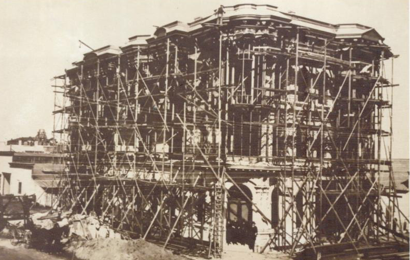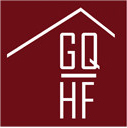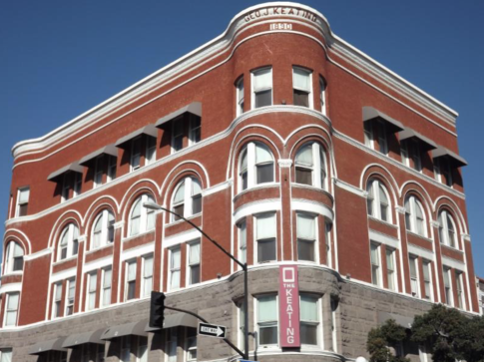Landmarks
Everybody Loves a Lover……
Keating Building, 1890
Architects: Reid Brothers
Architectual Style: Romanesque Revival
Everybody loves a good love story, and San Diego is no exception. The Keating building, a lovely Romanesque Revival gem on the northwest corner of 5th and F St., boasts two.
George and Fannie Keating arrived in San Diego from Kansas in 1886. As Mr. Keating was in ill health from rheumatic fever, they thought the balmy climate might restore his strength. Mr. Keating had previously owned one of the world’s largest firms dealing in farm equipment – Smith and Keating. Some of the proceeds from the sale of his business interests provided the basis for his next project – a high-end office building. George purchased much property in San Diego, including the two parcels on which the Keating was built. This he acquired from the estate of Charles P. Gerichten for the sum of $40,000. The Reid Brothers, architects of the Hotel del Coronado, were chosen to design the building. Fannie chose gray granite or Sespe sandstone for the building, while George would have preferred brick. Unfortunately, George passed away shortly before construction was begun, and in homage to her husband, Fannie had the building finished in red brick.

The building was completed in 1891 at a cost of $135,000, and was one of the most prestigious office buildings in San Diego, incorporating the modern conveniences of steam heat , a wire cage elevator, brass doorknobs and wall plates, a stunning light well and staircase, and provisions for both gas and incandescent electric lights. The elevator, which ran from the basement to the top floor, made every room in the building desirable. Fannie, a shrewd businesswoman, did her late husband proud.
Offices filled rapidly in the Keating Building. Among the early tenants were F. A. Flores and Company, forwarding agents for Lower California, attorneys Moses Luce, Cassius Carter, Puterbaugh and Puterbaugh and Works and Works, and physicians, dentists, architects, and photographers. A notable architect was Henry Lord Gay , the founder of the American Institute of Architecture.
Additionally, it was the home of the San Diego Public Library from 1901-1903. In 1903, the library moved to 8th and E St., where it remained until a new, state-of-the-art structure was opened in September 2013 at 330 Park Blvd.

Another noteworthy tenant from 1891 until 1913 was the San Diego Savings Bank, which later became San Diego Trust and Savings. The impressive bank vault is still in place in the basement of the Keating.
On September 5, 1908, the estate of Fannie Keating transferred the property to James R. McNeece, and the property was again transferred in 1943 to Morris and Ida Esther Sommer. Consequently, throughout the years, the building was also referred to as the McNeece and the Sommer building. However, the cast metal name – Geo. J. Keating- and the date 1890- at the top of the building clearly stand in testament to a woman’s great esteem for her husband and her desire to honor his name.
Another San Diego icon and a leader in the revitalization of the Gaslamp, Ingrid Croce, also honored her husband at the Keating. In one of her blogs she wrote about the week before Jim Croce’s untimely death in a plane crash. They had just moved to California, and were exploring downtown looking for a place to dine. They ended up in front of the Keating Building with no prospects in sight. Jim joked that they should open a restaurant and bar on that corner, and a dream was born.
Twelve long years later, Ingrid had lost her lease on the small restaurant she had opened in Hillcrest. Amazingly, an open store front had just become available in the Gaslamp – the ground floor of the Keating. It was meant to be. In 1985, Ingrid opened a restaurant and jazz bar, and named it Croce’s, in honor of her late husband. Dreams do come true! Croce’s became one of the most popular night spots in the Gaslamp until its closing in 2013. The Croce’s son, A.J., performed regularly at the jazz bar and carried on his father’s legacy , as he is also a singer and songwriter.
The Keating now houses an exclusive boutique hotel that bridges the old with the new. The interior, designed by Pininfarina, the Italian team responsible for Masserati and Ferrari, is a striking blend of sleek modern style and sophisticated luxury. The public spaces feature black, white and Ferrari red with stainless steel and rich wood accents.
One historic building – two great love stories. Happy Valentine’s Day, San Diego!
Sandee Wilhoit is the Historian for the Gaslamp Quarter Historical Foundation.
She can be reached at [email protected]

